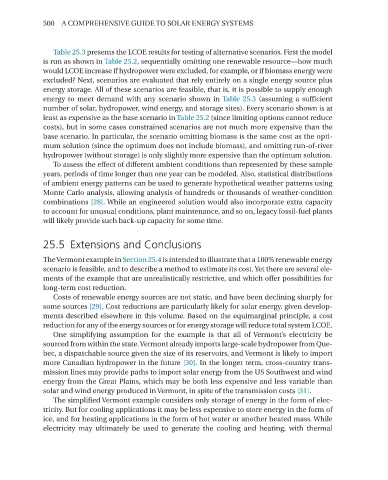Page 487 - A Comprehensive Guide to Solar Energy Systems
P. 487
500 A CoMPrEhEnsiVE GUidE To solAr EnErGy sysTEMs
Table 25.3 presents the lCoE results for testing of alternative scenarios. First the model
is run as shown in Table 25.2, sequentially omitting one renewable resource—how much
would lCoE increase if hydropower were excluded, for example, or if biomass energy were
excluded? next, scenarios are evaluated that rely entirely on a single energy source plus
energy storage. All of these scenarios are feasible, that is, it is possible to supply enough
energy to meet demand with any scenario shown in Table 25.3 (assuming a sufficient
number of solar, hydropower, wind energy, and storage sites). Every scenario shown is at
least as expensive as the base scenario in Table 25.2 (since limiting options cannot reduce
costs), but in some cases constrained scenarios are not much more expensive than the
base scenario. in particular, the scenario omitting biomass is the same cost as the opti-
mum solution (since the optimum does not include biomass), and omitting run-of-river
hydropower (without storage) is only slightly more expensive than the optimum solution.
To assess the effect of different ambient conditions than represented by these sample
years, periods of time longer than one year can be modeled. Also, statistical distributions
of ambient energy patterns can be used to generate hypothetical weather patterns using
Monte Carlo analysis, allowing analysis of hundreds or thousands of weather-condition
combinations [28]. While an engineered solution would also incorporate extra capacity
to account for unusual conditions, plant maintenance, and so on, legacy fossil-fuel plants
will likely provide such back-up capacity for some time.
25.5 Extensions and Conclusions
The Vermont example in section 25.4 is intended to illustrate that a 100% renewable energy
scenario is feasible, and to describe a method to estimate its cost. yet there are several ele-
ments of the example that are unrealistically restrictive, and which offer possibilities for
long-term cost reduction.
Costs of renewable energy sources are not static, and have been declining sharply for
some sources [29]. Cost reductions are particularly likely for solar energy, given develop-
ments described elsewhere in this volume. Based on the equimarginal principle, a cost
reduction for any of the energy sources or for energy storage will reduce total system lCoE.
one simplifying assumption for the example is that all of Vermont’s electricity be
sourced from within the state. Vermont already imports large-scale hydropower from Que-
bec, a dispatchable source given the size of its reservoirs, and Vermont is likely to import
more Canadian hydropower in the future [30]. in the longer term, cross-country trans-
mission lines may provide paths to import solar energy from the Us southwest and wind
energy from the Great Plains, which may be both less expensive and less variable than
solar and wind energy produced in Vermont, in spite of the transmission costs [31].
The simplified Vermont example considers only storage of energy in the form of elec-
tricity. But for cooling applications it may be less expensive to store energy in the form of
ice, and for heating applications in the form of hot water or another heated mass. While
electricity may ultimately be used to generate the cooling and heating, with thermal

